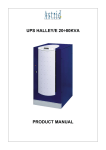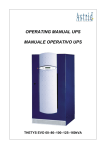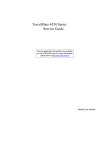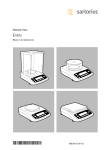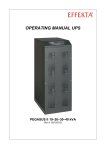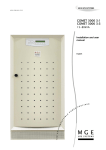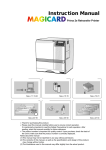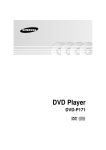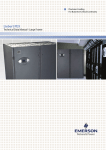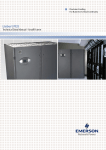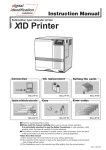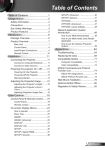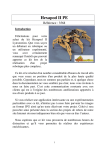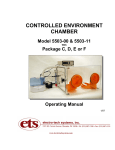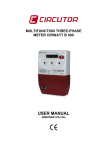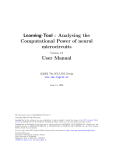Download OM497010_Infinity_3100-3300
Transcript
UPS OPERATING MANUAL INFINITY 3100 – INFINITY 3300 UPS OPERATING MANUAL Index of sections Code 1 – UPS GENERAL DESCRIPTION AND INSTALLATION OM497011 2 – FRONT PANEL OM497012 3 – START-UP, SHUT-DOWN AND MANUAL BYPASS OM497013 4 – REMOTE CONNECTION OF THE UPS OM497014 Rev. A B Descrizione Description First issue Modify picture Data Date 16.09.05 04.03.08 Emesso Issued Controllato Checked M. Mancini E.Simoni A. Mangani M. Mancini Approvato Approved Lingua Language Pagina Page E.Simoni V. Gremoli E 1 di Pag. of Pag. 1 Codice / Code OM497010 Ups general description & installation UPS GENERAL DESCRIPTION AND INSTALLATION Index 1. INTRODUCTION................................................................................. 4 1.1 1.1.1 ISO 14001 certification.............................................................................4 1.1.2 Packing .....................................................................................................4 1.1.3 Lead battery..............................................................................................4 1.1.4 Treatment of UPS at the end of life cycle...............................................4 1.2 Safety of persons .....................................................................................4 1.2.2 Product safety ..........................................................................................5 1.2.3 Special precautions .................................................................................5 UPS GENERAL DESCRIPTION......................................................... 7 2.1 TYPOLOGY ......................................................................................................7 2.2 SYSTEM DESCRIPTION ..................................................................................8 2.2.1 Rectifier.....................................................................................................8 2.2.2 Inverter ......................................................................................................8 2.2.3 Battery and battery charger ....................................................................8 2.2.4 Static bypass ............................................................................................8 2.2.5 Manual bypass .........................................................................................8 2.2.6 Front panel................................................................................................9 2.3 Rev. B C D E SAFETY RULES ...............................................................................................4 1.2.1 2. 3. ENVIRONMENT................................................................................................4 OPERATING STATUS....................................................................................10 2.3.1 Normal operation ...................................................................................10 2.3.2 Load supplied by bypass due to inverter fault ....................................10 2.3.3 Rectifier failure or mains failure ...........................................................11 2.3.4 Manual bypass .......................................................................................11 INSTALLATION................................................................................ 12 Descrizione Description Added connection 3,3Ah batteries Added external battery cabinet Added 30-40kVA sizes Added 12Ah external battery cabinet Data Date 21.12.05 06.02.06 29.11.07 04.03.08 Emesso Issued Controllato Checked E.Biancucci F. Orlandi F. Orlandi V. Gremoli M. Mancini V. Gremoli A. Mangani M. Mancini Approvato Approved M. Mancini V. Gremoli V. Gremoli V. Gremoli Lingua Language Pagina Page di Pag. of Pag. E 1 28 Codice / Code OM497011 Ups general description & installation 3.1 RECEIPT OF THE UPS ................................................................................. 12 3.2 HANDLING OF THE UPS .............................................................................. 12 3.3 POSITIONING AND INSTALLATION ............................................................ 13 3.3.1 Base plan, static load and weights ...................................................... 13 3.3.2 Dimensions and distances ................................................................... 14 3.4 ELECTRICAL CONNECTION........................................................................ 15 3.4.1 3.5 Terminal board ...................................................................................... 16 BATTERY ...................................................................................................... 18 3.5.1 Battery connection and positioning .................................................... 19 3.5.1.1 3,3Ah 12V battery connection and positioning – INFINITY 10kVA 19 3.5.1.2 20kVA 7Ah / 9Ah 12V battery connection and positioning–INFINITY 10-1521 3.6 FUSES POSITIONING BCB – INFINITY 10-15-20KVA................................. 23 3.7 AS553 EXTERNAL BATTERY ...................................................................... 24 3.7.1 Dimensions and weights ...................................................................... 25 3.7.2 7Ah/9Ah/12Ah 12V battery connection and positioning .................... 26 3.7.3 Connections........................................................................................... 28 Index of pictures Picture 1 – Block diagram............................................................................................................................. 7 Picture 2 – Normal operation...................................................................................................................... 10 Picture 3 – Load supplied by bypass.......................................................................................................... 10 Picture 4 – Rectifier failure or mains failure................................................................................................ 11 Picture 5 – Manual bypass ......................................................................................................................... 11 Picture 6 – Handling of UPS up to 40 kVA ................................................................................................. 12 Picture 7 – Base plan.................................................................................................................................. 13 Picture 8 – Dimensions and distances from the walls ................................................................................ 14 Picture 9 – Terminal board INFINITY 3100 10-15-20kVA .......................................................................... 16 Picture 10 – Terminal board INFINITY 3300 10-15-20kVA ........................................................................ 17 Picture 11 – Terminal board INFINITY 3300 30-40kVA ............................................................................. 17 Picture 12 – Paperboard 3,3Ah battery protection ..................................................................................... 19 Picture 13 – 3,3Ah battery connection........................................................................................................ 20 Picture 14 – 3,3Ah battery connected ........................................................................................................ 20 Picture 15 – Paperboard 7Ah/9Ah battery protection................................................................................. 21 Picture 16 – 7Ah/9Ah battery connection ................................................................................................... 21 2 OM497011 Rev. E Ups general description & installation Picture 17 – 7Ah/9Ah battery connected.................................................................................................... 22 Picture 18 – Cabling of BCB fuse holder.................................................................................................... 22 Picture 19 – Fuses positioning on the fuseholder BCB.............................................................................. 23 Picture 20 – Base plan of the external battery cabinet............................................................................... 25 Picture 21 – Dimensions of the external battery cabinet............................................................................ 25 Picture 22 – Paperboard 7Ah/9Ah/12Ah battery protection ....................................................................... 26 Picture 23 – 7Ah/9Ah/12Ah battery connection ......................................................................................... 26 Picture 24 – 7Ah/9Ah/12Ah battery connected .......................................................................................... 27 Picture 25 – Battery circuit breaker and fuses............................................................................................ 27 Picture 26 – Battery cabinet and UPS connections ................................................................................... 28 OM497011 Rev. E 3 Ups general description & installation 1. INTRODUCTION Congratulation for the choice of an Astrid Energy Enterprises product for the safety of your devices. To use at the best the performances of your INFINITY UPS we suggest you to read with attention the present manual. The scope of this manual is to describe briefly the parts that constitute the UPS and to guide the installer and the user to the correct installation of the system in the chosen room. The installer and the user will have to read this manual with care and attention and correctly carry-out the instructions provided, especially those relevant to security according to the country standards in force. WARNING THE UPS CAN BE INSTALLED BY QUALIFIED PERSONNEL ONLY. THE UPS CAN BE OPERATED BY EXPERIENCED PERSONNEL. 1.1 ENVIRONMENT 1.1.1 ISO 14001 certification Astrid Energy Enterprises pays particularly attention at environmental impact of its products; for this reason development of INFINITY UPS is carried out with an ecological approach in compliance of ISO 14001 certificate. 1.1.2 Packing UPS packing materials must be recycled in compliance with all applicable regulations. 1.1.3 Lead battery This product contains lead-acid batteries. Lead is a dangerous substance for the environment if it is not correctly recycled by specialised companies. 1.1.4 Treatment of UPS at the end of life cycle For the UPS disposal at the end of its life cycle and for the recycling of the materials, it’s strongly recommended to follow the regulations in force in the country of installation. 1.2 SAFETY RULES 1.2.1 Safety of persons The UPS must be installed in a room with restricted access (qualified personnel only, according to standard EN62040-1-2). A UPS has its own internal power source (the battery). Consequently, the power outlets may be energised even if the UPS is disconnected from the AC-power source. 4 OM497011 Rev. E Ups general description & installation CAUTION If primary powers isolators are installed in other area from UPS area. You must stick the following warning label on them. “ISOLATE UNINTERRUPTIBLE POWER SUPPLY (UPS) BEFORE WORKING ON THIS CIRCUIT” Dangerous voltage levels are present within the UPS. It should be opened exclusively by qualified service personnel. Warning, after the UPS shut-down, a dangerous voltage will be present on the battery selector BCB. The UPS must be properly earthed. The battery supplied with the UPS contains small amounts of toxic materials. To avoid accidents, the directives listed below must be observed. w Never operate the UPS if the ambient temperature and relative humidity are higher than the levels specified in the documentation. Never burn the battery (risk of explosion). w Do not attempt to open the battery (the electrolyte is dangerous for the eyes and skin). w Comply with all applicable regulations for the disposal of the battery. 1.2.2 Product safety A protection circuit breaker must be installed upstream and be easily accessible. Never install the UPS near liquids or in an excessively damp environment. Never let a liquid or foreign body penetrate inside the UPS. Never block the ventilation grates of the UPS. Never expose the UPS to direct sunlight or a source of heat. 1.2.3 Special precautions The UPS connection instructions contained in this manual must be followed in the indicated order. w Check that the indications on the rating plate correspond to your AC-power system and to the actual electrical consumption of all the equipment to be connected to the UPS. w If the UPS must be stored prior to installation, storage must be in a dry place. w The admissible storage temperature range is -10° C to +45° C. w If the UPS remains de-energised for a long period, we recommend that you energise the UPS for a period of 24 hours, at least once every month. This charges the battery, thus avoiding possible irreversible damage. w The UPS is designed for normal climatic and environmental operating conditions as defined in the "appendices" chapter: altitude, ambient operating temperature, relative humidity and ambient transport and storage conditions. w Using the UPS within the given limits guarantees its operation, but may affect the service life of certain components, particularly that of the battery and its autonomy. The maximum storage time of the UPS is limited due to the need to recharge its integrated battery. w OM497011 Rev. E 5 Ups general description & installation Unusual operating conditions may justify special design or protection measures: harmful smoke, dust, abrasive dust, humidity, vapor, salt air, bad weather or dripping, explosive dust and gas mixture, extreme temperature variations, bad ventilation, conductive or radiant heat from other sources, strong electromagnetic fields, radioactive levels higher than those of the natural environment, fungus, insects, vermin, etc., battery operating conditions. w The UPS must always be installed in compliance with: - the requirements of HD 384.4.42 S1/A2 - Chapter 42: thermal effects. - standard IEC 60364-4-482 - Chapter 482: Fire protection. Protection from The manufacturer declines all responsibility for damages to people or equipment deriving from non-fulfilment of the above. 6 OM497011 Rev. E Ups general description & installation 2. UPS GENERAL DESCRIPTION 2.1 TYPOLOGY All UPS covered by this manual are on-line, double conversion; the inverter supplies always energy to the load, whether mains is available or not (according to the battery autonomy time). WARNING The UPS output is energized even during mains failure, therefore in compliance with the prescriptions of EN 62040-1, the installer will have to identify the line or the plugs supplied by the UPS making the User aware of this fact. This configuration guarantees the best service to the User, as it supplies clean continuously regulated power and guarantees the voltage and frequency will be stabilised at nominal value independently from mains status. Thanks to the double conversion, it makes the load completely immune from micro-interruptions due to excessive mains variation, and prevents damage to the critical load (Computer Instrumentation - Scientific equipment etc.). Picture 1 – Block diagram OM497011 Rev. E 7 Ups general description & installation 2.2 SYSTEM DESCRIPTION 2.2.1 Rectifier It converts the three phase voltage of the mains into continuous DC voltage. It uses a three phase - low harmonics - fully-controlled IGBT’s bridge. It’s designed to supply the inverter at full load and the battery at the maximum recharging current. This configuration is used to reduce the distortion of the current absorbed from the mains (THD) to a value <5%. This ensures that the rectifier does not distort the supply mains, with regard to the other loads; it also avoids the overheating of the cables due to the harmonics circulation. 2.2.2 Inverter It converts the continuous voltage coming from the rectifier or from the battery into alternating voltage stabilized in amplitude and frequency. The inverter uses IGBT technology with a frequency commutation of approximately 15 KHz. The control electronics is completely digital and uses a 32 Bit μP, that, by the means of its processing capability, generates an excellent output sine-wave, which has a very low distortion even in presence of loads having high crest factor currents. 2.2.3 Battery and battery charger The battery is housed inside the UPS (only for INFINITY 10-15-20kVA) and in an external battery cabinet for higher battery ratings. The battery charger control logic is completely integrated inside the rectifier control board; the battery is charged, according to the DIN 41773 Standard, every time it has been partially or completely discharged and it is kept floating, even when it’s charged, to compensate for any autodischarge. 2.2.4 Static bypass It’s designed to transfer the load between INVERTER and MAINS, and vice-versa, without break, and uses SCR’s as power commutation elements. 2.2.5 Manual bypass It‘s used to by-pass the UPS, supplying the load directly to the mains in case of maintenance or serious failure. WARNING The sequence of bypass switching must be carried out with respect to the procedure indicated on the UPS and in the chapter “Start-up, shut-down and manual bypass”. The manufacturer cannot accept responsibility for damages arising from incorrect operation. 8 OM497011 Rev. E Ups general description & installation 2.2.6 Front panel The front panel of the UPS, consisting of a four row alphanumeric displays plus 5 function keys, allows the complete monitoring of the UPS status. The mimic diagram helps to understand the operating status of the UPS. For more information see the chapter “FRONT PANEL”. OM497011 Rev. E 9 Ups general description & installation 2.3 OPERATING STATUS The following paragraphs show all the possible operating status of the UPS. 2.3.1 Normal operation The inverter is supplied by the rectifier; the load, through the static switch, is supplied directly by the inverter output. Picture 2 – Normal operation 2.3.2 Load supplied by bypass due to inverter fault The load is transferred to bypass through the static switch; the transfer is carried out without interruption. Picture 3 – Load supplied by bypass 10 OM497011 Rev. E Ups general description & installation 2.3.3 Rectifier failure or mains failure The inverter is supplied by the battery for the required autonomy time; the load, through the static switch, is supplied directly by the inverter output. Picture 4 – Rectifier failure or mains failure 2.3.4 Manual bypass The load is supplied by the mains through the manual bypass; the operator can work in safety on the UPS to carry out maintenance or repairing operations. Picture 5 – Manual bypass OM497011 Rev. E 11 Ups general description & installation 3. INSTALLATION 3.1 RECEIPT OF THE UPS When the UPS is received, please attend immediately to its unpacking and carry-out an accurate visual check to be sure that the equipment has not been damaged during transport. IMPORTANT In case of objections relating to damage incurred during transport these must be immediately notified to the transportation company after receipt of the equipment. When the UPS is not installed immediately it must be stored carefully in vertical position, as indicated on the packing and conserved in a dry and sheltered room in its box so that it is protected from dust. 3.2 HANDLING OF THE UPS Before positioning the UPS, in order to avoid risks of turnover, it’s recommended to move the system on the wood pallet on which the UPS is fixed. Before the positioning in the final location, remove the UPS from the pallet. The UPS can be lifted and handled using a pallet truck or a forklift. - UPS up to 40 kVA The UPS’s up to 40 kVA (INFINITY 3100 and 3300 series) can be handled by means of the four wheels fixed on the bottom. The UPS technical data are shown on a label fixed on the rear. Picture 6 – Handling of UPS up to 40 kVA 12 OM497011 Rev. E Ups general description & installation 3.3 POSITIONING AND INSTALLATION The UPS must be installed in a clean and dry room, preferably not dusty. The User must ensure that there is enough air exchange in the room so that the equipment can be adequately cooled; if this is not guaranteed, the room must be adequately aired. If the UPS contains the batteries internally (INFINITY 10-15-20kVA) the air exchange with the external ambient will have to be according to EN 62040 -1, annex N. 3.3.1 Base plan, static load and weights Picture 7 – Base plan UPS (kVA) INFINITY 10 15 20 30 40 3100/3300 L1 – mm 450 P1 – mm 650 L2 – mm - INFINITY 3100 ( kVA) 10 15 20 Weight w/o battery – kg 90 100 100 Weight with battery – kg 250 260 260 Static load – kg/m2 840 890 890 INFINITY 3300 ( kVA) 10 15 20 30 40 Weight w/o battery – kg 90 100 100 141 141 Weight with battery – kg 250 260 260 - - Static load – kg/m2 840 890 890 483 483 OM497011 Rev. E 13 Ups general description & installation 3.3.2 Dimensions and distances Picture 8 – Dimensions and distances from the walls UPS (kVA) 10 15 20 3100/3300 450 P – mm 650 H – mm 1200 Y (min.) – mm ADD. CABINET 50 100 500 AS553 L1 – mm 500 P1 – mm 650 H1 – mm 1200 14 OM497011 Rev. E 40 3300 L – mm X (min.) – mm 30 Ups general description & installation 3.4 ELECTRICAL CONNECTION The electrical connection is part of the work which is normally provided by the supplier that carries out the electrical installation and not by the UPS manufacturer. For this reason, the following recommendations are only an indication, as the UPS manufacturer is not responsible for the electrical installation. In any case we recommend to carry-out the installation and the electrical connections of the input and output in compliance with the local standards. During the electrical installation take particular care to check the phase rotation with a suitable instrument. - UPS up to 20 kVA The terminal boards are placed on the rear of the UPS, under the breakers. To access the terminals remove the protection, removing the fixing bolts. - UPS 30-40 kVA The terminal boards are placed on the front of the UPS. To access the terminals remove the front panel, removing the fixing bolts. WARNING The connection to the mains must be carried out with protection fuses between the mains and the UPS. The use of residual current devices in the line supplying the UPS is unadvisable. The leakage current due to the RFI filters is rather high and it can cause spurious tripping of the protection device. According to the EN62040-1 standard, in order to take into account the UPS’ leakage current, residual current devices having adjustable threshold can be used. INCLUDE AN APPROPRIATE AND READLY ACCESSIBLE DISCONNECT DEVICE IN THE FIXING WIRE CONNECTING THE UPS TO THE MAINS To protect the output against electrical shock, use the following residual current devices: INFINITY 3300: DEVICE AS TYPE B (IEC/TR 60755/A2) INFINITY 3100: DEVICE AS TYPE A (IEC 61081-1 or IEC 61091-1) The connection cables section is shown in the following tables. INFINITY 3100 UPS (kVA) Input fuses (A) Input cables (mm2) 10 15 20 Rectifier 3x25 3x32 3x32 Bypass 1x80 1x110 1x150 Rectifier 3x6 3x10 3x10 Bypass 2x16 2x25 2x35 Output cables (mm2) 2x16 2x25 2x35 (mm2) 3x6 3x6 3x6 Battery cables OM497011 Rev. E 15 Ups general description & installation INFINITY 3300 UPS (kVA) Input fuses (A) Input cables (mm2) 10 15 20 30 40 Rectifier 3x25 3x32 3x32 3x70 3x70 Bypass - - - - - Rectifier 4x6 4x6 4x10 4x25 4x25 - - - - - Output cables (mm2) Bypass 4x6 4x6 4x10 4x25 4x25 Battery cables (mm2) 3x6 3x6 3x6 3x16 3x16 3.4.1 Terminal board Picture 9 – Terminal board INFINITY 3100 10-15-20kVA 16 OM497011 Rev. E Ups general description & installation Picture 10 – Terminal board INFINITY 3300 10-15-20kVA Picture 11 – Terminal board INFINITY 3300 30-40kVA OM497011 Rev. E 17 Ups general description & installation 3.5 BATTERY IMPORTANT For battery installation please respect the prescriptions of the EN62040-1 standard, paragraph 4.5. To obtain the battery life indicated by the battery manufacturer, the operating temperature must remain between 0 and 25 °C. However, although the battery can operate up to 40 °C , there will be a significant reduction of the battery life. To avoid the formation of any kind of potentially explosive hydrogen and oxygen mixture, suitable ventilation must be provided where the battery are installed (see EN62040-1 annex N). The batteries can be internal or external, however, it is recommended to install them when the UPS is capable of charging them. Please remember that, if the battery is not charged for periods over 2-3 months they can be subject to irreparable damage. IMPORTANT The infinity 3100 and 3300 from 10 kVA to 20 kVA, have internal batteries. Servicing of batteries should performed by qualified personnel only. Replace the batteries with the same number of block and capacity. Replace only with original type. CAUTION: do not dispose of batteries in fire. The battery may explode. CAUTION: do not open or mutilate batteries. Released electrolyte is harmful to the skin and eyes.It may be toxic. CAUTION: do not dump the exausted batteries in the environment. 18 OM497011 Rev. E Ups general description & installation 3.5.1 Battery connection and positioning 3.5.1.1 3,3Ah 12V battery connection and positioning – INFINITY 10kVA 1) Remove the four screws to open the front cover and access the battery trays. 2) Remove the paperboard cover protection from the batteries, see picture 12. Picture 12 – Paperboard 3,3Ah battery protection OM497011 Rev. E 19 Ups general description & installation 3) Connect the wires as shown on the picture 13. Picture 13 – 3,3Ah battery connection 4) After the connection re-insert the battery trays as shown in pictures 14. Picture 14 – 3,3Ah battery connected Put back and fix the front cover with the four screws. WARNING After the battery installation, before closing BCB, check the voltage polarity in the top and bottom of the BCB circuit breaker. 20 OM497011 Rev. E Ups general description & installation 3.5.1.2 7Ah / 9Ah 12V battery connection and positioning–INFINITY 10-15-20kVA 1) Remove the four screws to open the front cover and access the battery trays. 2) Remove the paperboard cover protection from the batteries, see picture 15. Picture 15 – Paperboard 7Ah/9Ah battery protection 3) Connect the wires as shown on the picture 16. Picture 16 – 7Ah/9Ah battery connection OM497011 Rev. E 21 Ups general description & installation 4) After the connection re-insert the battery trays as shown in picture 17. Picture 17 – 7Ah/9Ah battery connected Put back and fix the front cover with the four screws. WARNING After the battery installation, before closing BCB, check the voltage polarity in the top and bottom of the BCB circuit breaker. In case of not directly supplied cabling, please connect the cables to the battery breaker as shown in the below picture. Picture 18 – Cabling of BCB fuse holder 22 OM497011 Rev. E Ups general description & installation 3.6 FUSES POSITIONING BCB – INFINITY 10-15-20KVA After that the battery is correctly connected, insert the fuses and the neutral tube on the fuseholder (BCB), as shown in the picture 19. Picture 19 – Fuses positioning on the fuseholder BCB OM497011 Rev. E 23 Ups general description & installation 3.7 AS553 EXTERNAL BATTERY The battery cabinet can be used to increase the autonomy of the UPS “INFINITY 1015-20kVA” line for which the battery can be installed internally. IMPORTANT With the external battery the internal battery is never present. The battery cabinet is necessary for the UPS 30-40kVA. The battery cabinet is composed of two strings in parallel of 60 monoblocks 30+30, for a total of 120 monoblocks of 6 elements each. The size of the monoblocks can be 7Ah, 9Ah or 12Ah. - AS553 for 7Ah, 9Ah and 12Ah battery blocks. The battery circuit breaker and the battery fuses are installed inside the external battery cabinet, see picture 25. Concerning the installation of the external battery cabinet, refer to the details given in paragraph 3.5. WARNING In order to maintain the cabinet balanced, extract only one tray at a time. Before accessing the fuses, removing the protection, make sure that no voltage is present. 24 OM497011 Rev. E Ups general description & installation 3.7.1 Dimensions and weights The dimensions and weights of the external battery cabinet are indicates here under. Picture 20 – Base plan of the external battery cabinet Picture 21 – Dimensions of the external battery cabinet CABINET AS553 L – mm 500 P – mm 650 H – mm 1200 L1 – mm 500 P1 – mm 625 L2 – mm 50 CABINET Weight w/o battery – kg 7Ah 9Ah 12Ah 86 86 86 Weight with battery – kg 395 413 580 Static load with battery – kg/m2 1264 1321 1856 OM497011 Rev. E 25 Ups general description & installation 3.7.2 7Ah/9Ah/12Ah 12V battery connection and positioning 1) Remove the six screws to open the front cover and access the battery trays. 2) Remove the paperboard cover protection from the batteries, see picture 22. Picture 22 – Paperboard 7Ah/9Ah/12Ah battery protection 3) Connect the wires as shown on the picture 23. Picture 23 – 7Ah/9Ah/12Ah battery connection 26 OM497011 Rev. E Ups general description & installation 4) After the connection re-insert the battery trays as shown in picture 24. Picture 24 – 7Ah/9Ah/12Ah battery connected Put back and fix the front cover with the six screws. WARNING After the connection of the batteries, connect battery cabinet to the UPS as indicated on 3.7.3 paragraph before to close BCB. Picture 25 – Battery circuit breaker and fuses OM497011 Rev. E 27 Ups general description & installation 3.7.3 Connections The following picture shows the electrical connection between the UPS and the external battery cabinet. Picture 26 – Battery cabinet and UPS connections For the connection above mentioned you can use the cables supplied in the battery cabinet. 28 OM497011 Rev. E Front panel FRONT PANEL Index 1. INTRODUCTION...................................................................................3 2. DESCRIPTION......................................................................................3 2.1 MIMIC DESCRIPTION ......................................................................................3 2.2 ALARMS AND OPERATING STATUS.............................................................5 3. LCD DISPLAY MANAGEMENT...........................................................9 3.1 DEFAULT..........................................................................................................9 3.2 MAIN MENU......................................................................................................9 3.3 MEASURES ....................................................................................................10 3.3.1 Input ........................................................................................................12 3.3.2 Output .....................................................................................................13 3.3.3 Bypass ....................................................................................................14 3.3.4 Inverter ....................................................................................................15 3.3.5 AC/DC......................................................................................................15 3.3.6 Battery.....................................................................................................16 3.4 3.4.1 UPS Status..............................................................................................17 3.4.2 History.....................................................................................................18 3.4.3 List of alarms and status .......................................................................20 3.5 Rev. A B C ALARMS .........................................................................................................17 SPECIAL.........................................................................................................21 3.5.1 UPS Reset ...............................................................................................22 3.5.2 Clock Settings ........................................................................................22 3.5.3 UPS Language........................................................................................23 3.5.4 UPS Test .................................................................................................23 3.5.5 Battery test .............................................................................................23 3.5.6 Reset history ..........................................................................................23 Descrizione Description First Issue Modify alarms Added menu Data Date Emesso Issued Controllato Checked Approvato Approved 16.09.05 10.11.05 26.04.06 M. Mancini M. Mancini M. Mancini E. Simoni E. Simoni V. Gremoli E. Simoni E. Simoni V. Gremoli Lingua Language Pagina Page di Pag. of Pag. E 1 29 Codice / Code OM497012 Front panel 3.6 INFO ............................................................................................................... 24 3.6.1 Serial Number ........................................................................................ 25 3.6.2 UPS Type.................................................................................................... 26 3.6.3 Parallel (Option)..................................................................................... 27 3.6.4 Mod-Bus (Option) .................................................................................. 28 3.6.5 Firmware ................................................................................................ 28 3.7 MENU STRUCTURE...................................................................................... 29 Index of pictures Picture 1 - Front panel INFINITY 3100 and 3300 ......................................................................................3 Picture 2 - Structure Menu .....................................................................................................................29 2 OM497012 Rev. C Front panel 1. INTRODUCTION The front panel of the UPS, consisting of a four-row alphanumeric display plus 5 function keys, allows the complete monitoring of the UPS status. The mimic flow helps to understand the operating status of the UPS. Picture 1 - Front panel INFINITY 3100 and 3300 2. DESCRIPTION 2.1 MIMIC DESCRIPTION Picture1 shows the mimic present on the display, with the names of the circuit breakers/isolator switches of the UPS. Also the led's and blocks that comprise the UPS are clearly identified. LED 1 ⇒ Lit-up green = Mains present at the rectifier input. Green flashing = Wrong input phase sequence. Off = Rectifier input mains fault. LED 2 ⇒ Lit-up green = Emergency line present and in order. Green flashing = Wrong bypass phase sequence. Off = Emergency line (bypass) fault. LED 3 ⇒ Lit-up green = Rectifier feeding correctly. Green flashing = Rectifier in alarm. Lit-up red = Inverter input voltage out of tolerance. LED 4 ⇒ Lit-up green = Battery OK. Green flashing = Battery discharging or battery in test. Orange flashing = BCB open. Lit-up red = Battery test aborted. LED 5 ⇒ Lit-up green = Inverter static switch closed. Otherwise off. OM497012 Rev. C 3 Front panel 4 LED 6 ⇒ Lit-up orange = Emergency line static switch closed. Load retransfer blocked. Otherwise Off LED 7 ⇒ Lit-up green = OCB circuit breaker close. Otherwise Off LED 8 ⇒ Lit-up orange = Manual By-pass Circuit breaker closed. Otherwise Off. LED 9 ⇒ Lit-up red = EPO push-button pressed. Otherwise Off LED 10 ⇒ Orange flashing = Programmed service required, contact our service department. Lit-up orange = UPS fault, contact our service department. OM497012 Rev. C Front panel 2.2 ALARMS AND OPERATING STATUS The alphanumeric display offers a complete diagnostic of the system by showing 28 alarms and 6 operating status descriptions. Each alarm is associated to a code that allows it to be stored in the events history. A1 MAINS FAULT = Rectifier input mains failure Possible causes: 1) Central system black-out (mains failure) 2) Distribution problems upstream of the UPS 3) RCB open or blown fuses A2 INPUT WRONG SEQ = Input phase rotation not correct A3 BOOSTER STOPPED = The input rectifier is off. The battery is discharging. A4 BOOSTER FAULT = The input rectifier is out of order. The battery is discharging. A5 DC VOLT FAULT = Inverter input voltage out of tolerance Possible causes: 1) 2) 3) 4) 5) Mains input missing and battery fully discharged Distribution problems upstream of the UPS RCB open and or BCB open Rectifier bridge failure Inverter bridge failure A6 BATTERY IN TEST = Battery test in progress A7 BCB OPEN = Battery circuit breaker open A8 BATTERY DISCHAR = The battery is discharging Possible causes: 1) Rectifier input mains failure (alarm A1 or A2 present) 2) Booster stopped (alarm A3) 3) Booster fault (alarm A4) A9 BATTERY AUT END = Battery autonomy (calculated) has expired A10 BATTERY FAULT = Battery test failed Possible causes: 1) The test has been carried out with the battery not perfectly charged 2) One or more battery cells are damaged It is possible, after having verified the status of the battery, to reset this alarm by means of the front panel (see menu SPECIAL). OM497012 Rev. C 5 Front panel A11 SHORT CIRCUIT = Intervention of the short circuit protection (current exceeding 200%) Possible causes: 1) Problems on the load 2) Distribution problems downstream of the UPS A12 STOP MAX CURRENT = Inverter bridge stopped for max current Possible causes: 1) Short circuits for more than 5 sec. at the UPS output 2) Distribution problems downstream of the UPS It is possible, after having verified the status of the UPS, to reset this alarm by means of the front panel (see menu SPECIAL). A13 INV OUT TOLERAN = Inverter output voltage out of tolerance Possible causes: 1) Intervention of the inverter current limitation for excessive load (more than 200%) 2) Inverter failure 3) Inverter switched off (see alarm A12 or A25) A14 BYPASS WR SEQUEN = Bypass phase rotation not correct (3 ph. output only) A15 BYPASS FAULT = Emergency line not available for the bypass Possible causes: 1) 2) 3) 4) A16 BYPASS Æ LOAD = Emergency mains failure Distribution problems upstream of the UPS SBCB open Wrong input phase rotation (alarm A14) Load fed by bypass Possible causes: 1) Inverter overload 2) Thermal image intervention 3) Forced commutation due to the bypass switch operation (alarm A22) 4) Inverter failure 5) Load retransfer blocked on bypass (alarm A17) A17 RETRANSFER BLOCK = Retransfer between bypass and inverter blocked, load on bypass Possible causes: 1) Excessive repeated overloads on inverter It is possible, after having verified that the load is correct, to reset the UPS, and switch back the load to the inverter (see menu SPECIAL). 6 OM497012 Rev. C Front panel A18 MBYP CLOSE = Manual bypass breaker closed (the inverter is shutdown) A19 OCB OPEN = UPS output breaker open A20 OVERLOAD = Inverter overload (load exceeding 100%). The thermal image protection is started A21 THERMAL IMAGE = Intervention of the electronic protection due to excessive load A22 BYPASS SWITCH = Closure of the commutation switch which forces the load to bypass (maintenance) A23 EPO PRESSED = Intervention of the emergency power off switch according to the EN62040-1 It is possible, after having verified the status of the installation, to restart the UPS by means of the front panel (see menu SPECIAL). For an external EPO (Optional) the unit restart if the EPO push button is released. A24 HIGH TEMPERATURE = High temperature on the inverter and/or rectifier bridge Possible causes: 1) Excessive load 2) Failure or malfunctioning of the cooling system 3) Wrong positioning of the UPS (distance from walls, altitude) A25 INVERTER OFF = The inverter has been switched off A26 SSCI COM FAULT = Internal alarm A27 EEPROM ERROR = Internal alarm A28 UPS CRITICAL FAULT = Internal alarm Or of the Alarms A4-A5-A12-A13-A26-A27. A29 MAINTENANCE REQ = The programmed service timer has expired. A30 COMMON ALARM = One or more alarms are active A33 ASYMMETRIC LOAD = Check on “load asymmetry” (damage cables or asymmetric load) A34 SERVICE REQ = Contact the Service Support OM497012 Rev. C 7 Front panel A38 INV Æ LOAD 8 OM497012 Rev. C = Active only in ECO-MODE Inverter feed load Front panel 3. LCD DISPLAY MANAGEMENT 3.1 DEFAULT >> INFINITY 3100 << xxx kVA >> INFINITY 3300 << xxx kVA XXX V XXX YYY ZZZ V 1Ph UPS 3Ph UPS The default screen appears on the LCD panel when the UPS is in normal operation (with no alarm present); it shows the name of the UPS, the nominal power and the value of the output voltage. Pressing a key the main menu, with all the functions and parameters, is accessed After 5’ during which no key is pushed, if there isn’t any alarm and the battery is not in discharge mode the Default screen is shown again. If you press the key on this menu, the output currents first and then time and the date are shown. If you press the key you enter in the following menu. 3.2 MAIN MENU The screen of the main menu, equal for 1Ph and 3Ph UPS’s, appears as follows. < NAME > MEASURES < NAME > ALARMS < NAME > SPECIAL MEASURES menu. It is accessed pressing the key (see 3.3), or the pressing the keys other menu are scrolled down. ALARMS menu. It is accessed pressing the key (see 3.4), or the pressing the keys other menu are scrolled down. SPECIAL menu. It is accessed pressing the key (see 3.5), pressing the keys or the other menu are scrolled down. OM497012 Rev. C 9 Front panel < NAME > INFO INFO menu. It is accessed pressing the key (see 3.6), pressing the keys or the other menu are scrolled down. 3.3 MEASURES The following pictures shows the structure of the MEASURES menu. < MEASURES > INPUT < MEASURES > OUTPUT < MEASURES > BYPASS < MEASURES > INVERTER < MEASURES > AC/DC 10 OM497012 Rev. C INPUT measures. It is accessed pressing the key (see 3.3.1), pressing the keys or the other sub-menu are scrolled down. OUTPUT measures. It is accessed pressing the key (see 3.3.2), pressing the keys or the other sub-menu are scrolled down. BYPASS measures. It is accessed pressing the key (see 3.3.3), pressing the keys or the other sub-menu are scrolled down. INVERTER measures. It is accessed pressing the key (see 3.3.4), pressing the keys or the other sub-menu are scrolled down. DC measures. It is accessed pressing the key (see 3.3.5), pressing the keys or the other sub-menu are scrolled down. Front panel < MEASURES > BATTERY < MEASURES > EXIT BATTERY measures. It is accessed pressing the key (see 3.3.6), pressing the keys or the other sub-menu are scrolled down. Pressing the key the main menu screen is shown, pressing the keys or the other submenu are scrolled down. NOTE In the following paragraphs the sub-menu will be always represented as shown in the 3Ph UPS systems; the voltage measures are always referred to the phase-to-neutral value. The structure of the sub-menu for the 1Ph systems remains exactly the same, but the screens and the parameters are slightly different. OM497012 Rev. C 11 Front panel 3.3.1 Input INPUT VOLT/CURR XXX YYY ZZZ V xx.x yy.y zz.z A INPUT FREQUENCY XX.X Hz INPUT POWER XXXXX W POWER FACTOR X.XX < INPUT > EXIT 12 OM497012 Rev. C Pressing the key the following parameter is shown, while the key leads to the previous screen. Pressing the key the following parameter is shown, while the key leads to the previous screen. Pressing the key the following parameter is shown, while the key leads to the previous screen. Pressing the key the following parameter is shown, while the key leads to the previous screen. Pressing the key leads to the MEASURES menu screen (see 3.3), pressing the keys or the measures are shown again. Front panel 3.3.2 Output OUTPUT VOLT/CURR XXX YYY ZZZ V xx.x yy.y zz.z A OUTPUT POWER XXXXX W XXXXX VA OUTPUT FREQUENCY XX.X Hz LOAD %/OUTPUT CF XX YY ZZ % xx.x yy.y zz.z < OUTPUT > EXIT Pressing the key the following parameter is shown, while the key leads to the previous screen. Pressing the key the following parameter is shown, while the key leads to the previous screen. Pressing the key the following parameter is shown, while the key leads to the previous screen. Pressing the key the following parameter is shown, while the key leads to the previous screen. Pressing the key leads to the MEASURES menu screen (see or 3.3), pressing the keys the measures are shown again. OM497012 Rev. C 13 Front panel 3.3.3 Bypass BYPASS VOLTAGE XXX YYY ZZZ V BYPASS FREQUENCY XX.X Hz < BYPASS > EXIT 14 OM497012 Rev. C Pressing the key the following parameter is shown, while the key leads to the previous screen. Pressing the key the following parameter is shown, while the key leads to the previous screen. Pressing the key leads to the MEASURES menu screen (see 3.3), pressing the keys or the measures are shown again. Front panel 3.3.4 Inverter INVERTER VOLT/CURR XXX YYY ZZZ V xx.x yy.y zz.z A INVERTER FREQUENCY XX.X Hz < INVERTER > EXIT Pressing the key the following parameter is shown, while the key leads to the previous screen. Pressing the key the following parameter is shown, while the key leads to the previous screen. Pressing the key leads to the MEASURES menu screen (see 3.3), pressing the keys or the measures are shown again. 3.3.5 AC/DC This menu is active only when the battery is not discharging. If the battery is in discharge mode the menu BATTERY is automatically shown. AC/DC VOLTAGE POS. XXX V NEG. YYY V < AC/DC > EXIT Pressing the key the following parameter is shown, while the key leads to the previous screen. Pressing the key leads to the MEASURES menu screen (see 3.3), pressing the keys or the measures are shown again. OM497012 Rev. C 15 Front panel 3.3.6 Battery BATTERY VOLT/CURR POS: XXX V xx.x A NEG: YYY V yy.y A BATTERY TYPE XXX Ah BATTERY AUTONOMY XXX min YY % < BATTERY > EXIT 16 OM497012 Rev. C Pressing the key the following parameter is shown, while the key leads to the previous screen. Pressing the key the following parameter is shown, while the key leads to the previous screen. Pressing the key the following parameter is shown, while the key leads to the previous screen. Pressing the key leads to the MEASURES menu screen (see or the 3.3), pressing the key measures are shown again. Front panel 3.4 ALARMS This menu, when selected, shows the status of the equipment and the current alarms are shown (see list below). Each time an alarm occurs, the display goes to this menu to indicate the alarms present; the audible alarm can be silenced pressing the key . The exit is disabled if the alarm is not silenced. The following pictures shows the structure of the ALARMS menu. < ALARMS > UPS STATUS < ALARMS > HISTORY < ALARMS > EXIT Alarms and status of the UPS. It is accessed pressing the key (see 3.4.1), pressing the keys or the other sub-menu are scrolled down. Alarms history. It is accessed pressing the key (see 3.4.2), pressing the keys or the other sub-menu are scrolled down. Pressing the key the main menu screen is shown, pressing the keys or the other submenu are scrolled down. 3.4.1 UPS Status < UPS STATUS > 1st alarm/status < UPS STATUS > Last alarm/status Pressing the key the status and/or the alarm of the UPS are leads to shown, while the key the ALARMS menu screen (see 3.4). Pressing the key the status and/or the alarm of the UPS are shown, while the key leads to the ALARMS menu screen (see 3.4). OM497012 Rev. C 17 Front panel 3.4.2 History < HISTORY > 1st alarm/status Date Time < HISTORY > 2nd alarm/status Date Time < HISTORY > 3rd alarm/status Date Time < HISTORY > Last alarm/status Date Time Pressing the key the following alarm is shown; pressing the key exit the history, leading to the ALARMS menu screen (see 3.4). Pressing the key the following alarm is shown; pressing the key exit the history, leading to the ALARMS menu screen (see 3.4). Pressing the key the following alarm is shown; pressing the key exit the history, leading to the ALARMS menu screen (see 3.4). Pressing the key the first alarm is shown again; pressing the key exit the history, leading to the ALARMS menu screen (see 3.4). The first alarm shown is the most recent in order of time; a new alarm makes all the alarms shift one position, clearing the oldest event. For each event is shown the alarm code, the date and time; an asterisk next to the code indicates that the alarm has cleared at the date and time indicated. The following example shows two possible screens. < HISTORY > 2/6 25-12-2005 18 OM497012 Rev. C A01 23:08 Alarm A1 (MAINS FAULT) happened on 25/12/05 at 23:08. The position of this event in list is the second. The total events stored in the history are six. Front panel < HISTORY > 3/6 25-12-2005 A01* 23:12 Reset of alarm A1 (MAINS FAULT) on 25/12/05 at 23:12. The position of this event in the list is the third. The total events stored in the history are six. OM497012 Rev. C 19 Front panel 3.4.3 List of alarms and status List of alarms A1 MAINS FAULT A2 INPUT WRONG SEQ A3 BOOSTER STOPPED A4 BOOSTER FAULT A5 DC VOLTAGE FAULT List of status S1 BOOSTER OK A6 A7 A8 A9 A10 BATTERY IN TEST BCB OPEN BATTERY DISCHAR BATTERY AUT END BATTERY FAULT S2 BATTERY OK A11 A12 A13 SHORT CIRCUIT STOP MAX CURRENT INV OUT TOLERAN S3 INVERTER OK A14 A15 (**)A16 A17 BYPASS WR SEQUEN BYPASS FAULT BYPASS Æ LOAD RETRANFER BLOCK (**)S4 S5 S6 (*) S7 INV FEED LOAD INVERTER SYNCHRO BYPASS OK BYP Æ LOAD A18 A19 A20 A21 A22 A23 A24 A25 A26 A27 A28 A29 A30 A33 A34 (*)A38 MBYP CLOSE OCB OPEN OVERLOAD THERM IMAGE BYPASS SWITCH EPO PRESSED HIGH TEMPERATURE INVERTER OFF SSCI COM FAULT EEPROM ERROR UPS CRITICAL FAULT MAINTENANCE REQ COMMON ALARM ASYMMETRIC LOAD SERVICE REQ INV Æ LOAD (*) Active in ECO-MODE (**) Not active in ECO-MODE The status shown in this list are always displayed in ascending order when the STATUS menu is entered, the alarms are shown when they are present and must be silenced with the buzzer. The alarms remain displayed whilst they are present and they are automatically stored in the event history memory with date and time. 20 OM497012 Rev. C Front panel 3.5 SPECIAL IMPORTANT When entering the SPECIAL menu a password is required, as the operations which are allowed needs to be carried out by competent personnel. For each operation a confirmation is required. ENTER PASSWORD: 000 < SPECIAL > RESET < SPECIAL > CLOCK SETTINGS < SPECIAL > SELECT LANGUAGE < SPECIAL > UPS TEST Password entering; if wrong the main menu screen is shown again. Use the and to select the numbers, then confirm by . UPS RESET. It is accessed pressing the key (see 3.5.1), pressing the keys or the other sub-menu are scrolled down. CLOCK SETTINGS. It is accessed pressing the key (see 3.5.2), pressing the keys or the other sub-menu are scrolled down. SELECT LANGUAGE. It is accessed pressing the key (see 3.5.3), pressing the keys or the other sub-menu are scrolled down. UPS TEST. It is accessed pressing the key (see 3.5.4), pressing the keys or the other sub-menu are scrolled down. OM497012 Rev. C 21 Front panel < SPECIAL > BATTERY TEST < SPECIAL > RESET HISTORY < SPECIAL > EXIT BATTERY TEST. It is accessed pressing the key (see 3.5.5), pressing the keys or the other sub-menu are scrolled down. RESET HISTORY. It is accessed (see 3.5.6), pressing the key pressing the keys or the other sub-menu are scrolled down. Pressing the key the main menu screen is shown, pressing or the other subthe keys menu are scrolled down. 3.5.1 UPS Reset < RESET > PRESS RESET TO RESET UPS This menus provides a general reset of the UPS status pressing . the key leads to the Pressing the key special menu (see 3.5). 3.5.2 Clock Settings This menu allows to update time settings for the history of alarms. < CLOCK SETTINGS > 25-12-2001 22 OM497012 Rev. C 18:48 The numbers can be modified with the key or and they are confirmed by pressing . Pressing the key leads to the special menu (see 3.5). Front panel 3.5.3 UPS Language < SELECT LANGUAGE > 2 – ENGLISH The language can be modified with the key or and they are confirmed by pressing . Pressing the key leads to the special menu (see 3.5). 3.5.4 UPS Test < UPS TEST > PRESS RESET FOR COMMUTATION Pressing the key causes the commutation to bypass. Pressing the key leads to the special menu (see 3.5). 3.5.5 Battery test The BATTERY TEST cannot be started if this option is not enabled. < BATTERY TEST > PRESS RESET TO START TEST Pressing the key the battery test is started. Pressing the key leads to the special menu (see 3.5). WARNING - POSSIBLE LOSS OF LOAD! This test can affect the continuity of supply to the loads, if the battery is not fully charged. 3.5.6 Reset history < RESET HISTORY > PRESS RESET TO CLEAR HISTORY Pressing the key the alarms history is cleared. Pressing the key leads to the special menu (see 3.5). WARNING This operation causes the cancellation of the events stored in the history memory. OM497012 Rev. C 23 Front panel 3.6 INFO < INFO > SERIAL NUMBERS < INFO > UPS MODEL < INFO > PARALLEL < INFO > MODBUS < INFO > FIRMWARE < INFO > EXIT 24 OM497012 Rev. C SERIAL NUMBERS. Pressing (see 3.6.1), and then or you can look trough the sub-menu. UPS MODEL. Pressing you (see 3.6.2)and then or can look trough the sub-menu. PARALLEL. This menu is active only if our UPS is set in parallel. (see 3.6.3),and You can enter then pressing or you can look trough the sub-menu. MODBUS. You can enter pressing (see 3.6.4), and then or to look trough the submenu. FIRMWARE. You can enter pressing (see 3.6.5), and then or to look trough the submenu. Pressing you come back to the main menu, and then pressing or you can look trough the sub-menu. Front panel 3.6.1 Serial Number < UPS SERIAL NUMBER> << XXXXXXXXX >> < OEM SERIAL NUMBER > << XXXXXXXXX >> < SERIAL NUMBER > EXIT The UPS serial number set by the Supplier. Pressing you can enter the next parameter; pressing you come back to the main menu. Customized Serial Number. you can enter the Pressing next parameter while pressing you come back to the main menu. Pressing you come back to the INFO menu. (see 3.6), pressing or you can see the measurements. OM497012 Rev. C 25 Front panel 3.6.2 UPS Type < UPS Type> 3/3 < UPS Type > ON-LINE < UPS Type > SINGLE < UPS Type > EXIT 26 OM497012 Rev. C It indicates UPS’ input /output. You can see if the l’UPS is Threephase/ Threephase 3/3 or Threephase / Singlephase 3/1. you can enter the Pressing next parameter; pressing you can come back to the previous menu It indicates the UPS topology: ON-LINE ECO-MODE FREQ CONVERTER you can enter the Pressing next parameter; pressing you can come back to the previous menu It indicates the UPS configuration: Parallel or Stand Alone Pressing you can enter the you next parameter; pressing can come back to the previous menu Pressing you can come back to INFO menu (see 3.6), pressing or you can see the measurements. Front panel 3.6.3 Parallel (Option) The Parallel menu is active only of the UPS is in Parallel Configuration, otherwise you can not see it on the LCD display. < PARALLEL > n/N < PARALLEL > MASTER < PARALLEL > 1 2 3 4 5 6 E M S - - - - < PARALLEL > EXIT It indicates the UPS n position referring to the total number N of UPS belonging to the Parallel System. Pressing you can enter the next parameter; pressing you can come back to the previous menu. It indicates the UPS’ rule in the Parallel System; if it is Master or Slave. Pressing you can enter the you next parameter; pressing can come back to the previous menu. It indicates both the configuration status and the comunication status of the Parallel System. Please see the Parallel Kit Manual or the Parallel Operating Manual for further information. you can enter the Pressing next parameter; pressing you can come back to the previous menu. Pressing you can come back to INFO menu (see 3.6), pressing or you can see the measurements. OM497012 Rev. C 27 Front panel 3.6.4 Mod-Bus (Option) < MODBUS > ADDRESS 101 < MODBUS > EXIT It indicates the RS485 port address to the MOD-BUS Comunication System (Option). Please see the Option Manual for further information. Pressing you can enter the next parameter; pressing you can come back to the previous menu. Pressing you can come back to INFO menu (see 3.6), pressing or you can see the measurements. 3.6.5 Firmware < VERS FIRMWARE > BOOSTER:xx.yy INVERTER:xx.yy < VERS FIRMWARE > EXIT 28 OM497012 Rev. C Pressing you can enter the next parameter; pressing you can come back to the previous menu. Pressing you can come back to INFO menu (see 3.6), pressing or you can see the measurements. Front panel 3.7 MENU STRUCTURE Picture 2 - Structure Menu (*)The Parallel menu is active only of the UPS is in Parallel Configuration, otherwise you can not see it on the LCD display. OM497012 Rev. C 29 Start-up, shut-down & manual bypass START-UP, SHUTDOWN & MANUAL BYPASS Index 1. INTRODUCTION...................................................................................2 2. START-UP PROCEDURE ....................................................................2 2.1 START-UP BASIC TROUBLESHOOTING.......................................................3 3. SHUTDOWN PROCEDURE .................................................................4 4. MANUAL BYPASS PROCEDURE.......................................................4 5. START-UP FROM MANUAL BY-PASS...............................................5 Rev. A Descrizione Description First Issue Data Date Emesso Issued Controllato Checked Approvato Approved 16.09.05 M. Mancini E. Simoni E. Simoni Lingua Language Pagina Page di Pag. of Pag. E 1 5 Codice / Code OM497013 Start-up, shut-down & manual bypass 1. INTRODUCTION Before carrying out whatever procedure described in this chapter, read carefully the instructions, in order to avoid possible damages to persons or thing due to wrong manoeuvre. 2. START-UP PROCEDURE WARNING Before switching on the UPS, make sure: 1) the emergency power off “EPO” push-button, if provided, is in the release position; if not, press it and proceed with the start-up procedure; 2) the input and output phase rotation is correct. NOTE The breaker BCB is installed inside the UPS’s up to 20 kVA. Batteries and the relevant breaker for UPS systems having higher power are external. WARNING Do not close the battery breaker BCB before it’s required by the front panel. Serious damages to UPS internal parts may occur if the breaker is closed before the rectifier is started-up. Nr. LCD DISPLAYING 1 2 BLANK UPS START UP WAIT PLEASE 3 BOOSTER START UP WAIT PLEASE 4 INVERTER START UP WAIT PLEASE 5 BYPASS START UP CLOSE SBCB BYPASS START UP WAIT PLEASE 6 2 OM497013 Rev. A ACTION UPS OPERATION Close RCB The rectifier is supplied and the DC voltage increases up to the nominal value. All LED’s in the front panel are lit green. The microprocessor checks all the start-up conditions are ok. The rectifier IGBT bridge starts to modulate and the inverter intput voltage reaches the nominal value. After a while LED #3 is lit green. The inverter IGBT bridge starts to modulate and the inverter output voltage reaches the nominal value. After a while the inverter static switch thyristors close. LED #5 is lit green. Close SBCB The microprocessor checks that all the bypass parameters (voltage, phase sequence, frequency) are within the tolerance limits. LED #2 is lit green. Start-up, shut-down & manual bypass 7 8 9 10 End BATTERY START UP CLOSE BCB BATTERY START UP WAIT PLEASE START UP END CLOSE OCB START UP END WAIT PLEASE Close BCB The microprocessor checks all the conditions for the following step are ok. After a while LED #4 is lit green. Close OCB UPS MODEL OUTPUT VOLTAGE The microprocessor checks that all the output parameters (voltage, current, frequency) are within the tolerance limits. LED #7 is lit green. After a while the default screen is shown 2.1 START-UP BASIC TROUBLESHOOTING This paragraph provides the basic information if any alarms occur during the start-up procedure. In case the problem cannot be solved contact the service department. 1) After closing RCB the LCD display is still blank • Check the input voltage. • Check the rectifier protection fuses F1-F2-F3; they are inside the breaker RCB on INFINITY 3100 and 3300 up to 20 kVA. 2) After the step #2 the unit doesn’t switch to step #3 and shows the alarm A1 – Mains fault • Check if the alarm A2 is active. In case of alarm active, check the phase rotation of the line input. • Check the rectifier protection fuses F1-F2-F3; they are inside the breaker RCB on INFINITY 3100 and 3300 up to 20 kVA. 3) After the step #3 the unit shows alarms messages • Open RCB and check the UPS connections. • Close RCB and try to restart the UPS. 4) After the step #4 the unit shows alarms messages • Check the EPO push-button (if provided outside the unit) is in the release position. • Open RCB and check the UPS connections. • Close RCB and try to restart the UPS. 5) After the step #10 the unit shows the alarm A15 – Bypass fault • Check if the alarm A14 is active. In case of alarm active, check the phase rotation of the by-pass line input. • Check the static switch protection fuses; they are inside the breaker SBCB on on INFINITY 3100 and 3300 up to 20 kVA. 6) After the step #10 the unit shows the alarm A7 – BCB open • Check the fuses inside the breaker BCB. OM497013 Rev. A 3 Start-up, shut-down & manual bypass • 3. Nr. If an external battery cabinet is installed check the interconnections between the auxiliary contact of the battery breaker (in the external cabinet) and the terminals Bac1-Bac2 of the UPS. SHUTDOWN PROCEDURE ACTION 1 Open OCB 2 Open BCB 3 Open SBCB 4 Open RCB LCD DISPLAYING A30 GENERAL ALARM The supply to the load is interrupted. LED #7 off. A19 OCB OPEN A7 BCB OPEN The battery is disconnected from the rectifier. LED #4 orange flashing A15 BYP FAULT The by-pass line is disconnected. LED #2 off. A1 MAINS FAULT 5 4. UPS OPERATION BLANK The rectifier and inverter are switched off. Shut-down procedure end. MANUAL BYPASS PROCEDURE WARNING During manual bypass operation the load is supplied directly by the mains, therefore continuous supply is not guaranteed. Nr. 4 ACTION LCD DISPLAYING UPS OPERATION 1 Switch “NORMAL BYPASS” selector on BYPASS A30 GENERAL ALARM The load is transferred to the by-pass static switch. LED #5 off, LED #6 lit orange. A22 BYP SWITCH A16 BYP Æ LOAD 2 Close MBCB A31 MBYPBUS CLOSE The load is supplied by the mains through A25 INVERTER STOP the manual by-pass circuit breaker. The inverter is switched off. LED #8 lit A18 MBY CLOSE orange. 3 Open OCB 4 Open SBCB 5 Open BCB A7 BCB OPEN 6 Open RCB BLANK OM497013 Rev. A A19 OCB OPEN LED #7 Off. The Inverter Restart. A15 BYPASS FAULT LED #5 lit green, LED #6 Off, LED #2 Off no /A25 INVERTER STOP Bypass. The Battery is disconnected. LED #4 flashing orange. The load is now supplied directly by the mains through the manual by-pass circuit breaker. The UPS is isolated. Start-up, shut-down & manual bypass 5. START-UP FROM MANUAL BY-PASS Before the start-up from manual by-pass (after a maintenance or repairing) check that the “NORMAL-BYPASS” switch is in BYPASS position. Nr. LCD DISPLAYING 1 2 BLANK UPS START UP WAIT PLEASE 3 BYPASS STARTUP CLOSE SBCB BYPASS STARTUP WAIT PLEASE 4 5 6 7 8 9 10 11 ACTION UPS OPERATION Close RCB Close SBCB The rectifier is supplied and the DC voltage increases up to the nominal value. All LED’s in the front panel are lit. The microprocessor checks all the startup conditions are ok. LED’s #1 is lit green and #6 are lit orange. LED #8 is lit orange. LED #1 LED #3 is lit green, LED #6 LED #8 is lit orange. The microprocessor checks that all the by-pass parameters (voltage, phase sequence, frequency) are within the tolerance limits. LED #2 is lit green. The by-pass static switch is closed, LED #6 is lit orange. CLOSE BCB The microprocessor checks all the Close BCB conditions for the following step are ok. WAIT PLEASE LED #4 is lit green. CLOSE OCB The load is supplied by the by-pass Close OCB static switch. The breaker MBCB is still WAIT PLEASE closed. LED #7 is lit green. OPEN MBCB The load is now supplied by the by-pass Open MBCB static switch only and the inverter can be WAIT PLEASE started-up. LED #8 is off. The inverter IGBT bridge starts to INVERTER START UP modulate and the inverter output voltage WAIT PLEASE reaches the nominal value. The microprocessor checks the synchronisation with the by-pass line. MOVE BYP-SWITCH Move the “NORMAL- The load is transferred to the inverter BYPASS” switch on static switch. LED #5 is lit green. LED #6 WAIT PLEASE NORMAL is off. START UP END The microprocessor checks that all the output parameters (voltage, current, WAIT PLEASE frequency) are within the tolerance limits. UPS MODEL After a while the default screen is shown OUTPUT VOLTAGE OM497013 Rev. A 5 Remote connection of the UPS REMOTE CONNECTION OF THE UPS Index 1. REMOTE CONNECTIONS BY RS232 OR USB...................................2 1.1 INTRODUCTION...............................................................................................2 1.2 CONNECTION RS232 PORT ...........................................................................2 1.3 CONNECTION BY USB PORT.........................................................................3 2. REMOTE CONNECTION BY RS485 (OPTIONAL) .............................3 2.1 3. DESCRIPTION..................................................................................................3 REMOTE CONNECTION BY SRC (OPTIONAL).................................3 3.1 DESCRIPTION..................................................................................................3 Index of pictures Picture 1 – RS232-USB Ports ................................................................................................................. 2 Picture 2 – RS232 connection cable........................................................................................................ 2 Rev. A B Descrizione Description First Issue Modify par. 2 and 3 Data Date 16.09.05 20.10.05 Emesso Issued Controllato Checked M. Mancini E. Simoni E.Biancucci M. Mancini Approvato Approved Lingua Language Pagina Page di Pag. of Pag. E. Simoni E. Simoni E 1 3 Codice / Code OM497014 Remote connection of the UPS 1. REMOTE CONNECTIONS BY RS232 OR USB 1.1 INTRODUCTION The INFINITY UPS is provided with a RS232 port and an USB port as standard. Picture 1 – RS232-USB Ports 1.2 CONNECTION RS232 PORT The UPS can be connected to a monitoring Device/Software through a RS232 standard port with a RS232 standard cable (Male-Female DB9). The UPS data on the RS232 are transferred according to a Question-Answer Proprietary Protocol. The Settings parameters of the RS232 on the INFINITY are: Baud Rate = 9600 Parity = None Data = 8 BitStop = 1 NOTE Ask the UPS Manufacturer for more information about the UPS Protocol The connection cable is built as follows: Picture 2 – RS232 connection cable 2 OM497014 Rev. B Remote connection of the UPS 1.3 CONNECTION BY USB PORT Instead of using the RS232 serial connection it is possible to connect a monitoring device through the USB Port. In this case when the USB cable is plugged into the USB port and to the monitoring Device (ex. PC) the RS232 is automatically switched off. The USB Driver is on the CD Monitoring Software. The USB cable is a standard USB Cable. 2. REMOTE CONNECTION BY RS485 (OPTIONAL) 2.1 DESCRIPTION When required it’s possible to install on the INFINITY UPS the optional card RS485 SLOT_REM. Through the RS485 interface the UPS can be remotely monitored up to 400m. The protocol implemented on the RS485 port is a MOD-BUS RTU standard protocol. For further information about the functions of the MOD-BUS protocol and the installation of the card refer to the “Remote connection by RS485 - Installation and user manual”. 3. REMOTE CONNECTION BY SRC (OPTIONAL) 3.1 DESCRIPTION The SRC card is used to repeat to a remote location some UPS statuses and alarms, by means of SPDT (Single-Pole-Double-Throw) voltage free contacts. In normal condition with no Alarms and all Statuses OK, all the relays are energized. For further information about the installation of the card refer to the “SRC Signalling Remote Card - Installation and user manual”. OM497014 Rev. B 3 FACTORY & HEAD OFFICE Viale Europa, 22 - Loc. Ponte d’Arno 52018 CASTEL SAN NICCOLO’ (AR) Phone: +39-0575-509701 Fax: +39-0575-500032 http://www.astridups.it









































































